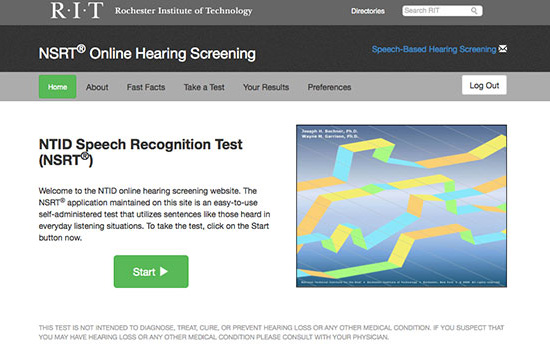NTID offers online speech recognition test
Self-screening test can determine whether hearing aids may help
RIT’s National Technical Institute for the Deaf has launched a website featuring an online speech recognition test that provides individuals with one tool to determine whether they may benefit from hearing aids, allowing them to seek help sooner if that’s the case.
Rochester Institute of Technology’s National Technical Institute for the Deaf has launched a website that provides individuals with one tool to determine whether they may benefit from hearing aids, allowing them to seek help sooner if that’s the case.
The test is free and can be found at the NSRT
“The test provides useful information and is recommended for anyone who is suspected of having a hearing loss,” said Joseph Bochner, who, with Wayne Garrison, worked on the website as a research project for several years.
Bochner, chairman of NTID’s cultural and creative studies department, and Garrison, a research faculty member in NTID’s Center on Access Technology, have spent years making sure the online test provides more accurate results than previously existing online tests offered elsewhere.
“This is a powerful diagnostic measure that has significant advantages over other measures of speech recognition,” Bochner said.
“The methods which we employ in our testing software have evolved from a unique cross-disciplinary combination of three distinct and generally unrelated fields: language sciences, audiology and psychometrics,” Garrison said. “The confluence of information from these diverse fields has resulted in a new approach to issues addressed in the hearing healthcare profession.”
Garrison said it historically takes seven or more years for someone who suspects they have difficulty hearing to seek help from a doctor or audiologist. The fact that this test is free, easy to access and is anonymous hopefully will encourage more people to take it, he added.
The test features sentences that appear on the screen. A voice speaks each sentence and in some cases, the audio matches the sentence. In other cases, the audio may be slightly different than what appears in the text. It is the user’s job to determine whether or not the audio matches the sentence.
A practice question from the test: “Did you notice the car on Main Street?” was printed, and spoken audio said, “Did you notice the tar on Main Street?”
According to experts, there are different degrees of hearing loss. Most hearing losses involve high frequencies and make parts of words difficult to comprehend. Although many people who have trouble hearing adapt by guessing what they thought they heard, the test shows how the slightest miscommunication can have different meanings.
Bochner says NTID’s test is “a diagnostic measure that has significant advantages over other measures of speech recognition.” Those who score low are urged to follow up with a medical professional to see if they may benefit from audiological services.
Users need to provide an email address to take the test, but that’s to allow them to return in the future and compare results to see whether their hearing may have improved or deteriorated.













